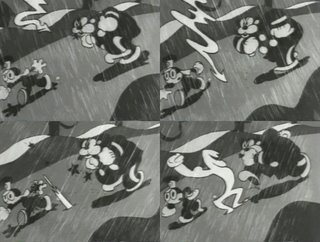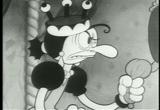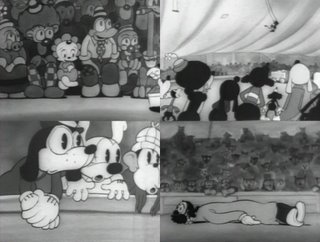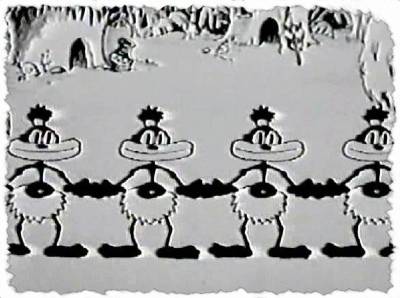SPECIFIC VERSUS GENERIC RUBBER HOSE CARTOONS
I used to not like rubber hose cartoons because I thought they were primitive, and in some technical senses they are, compared to what the same animators did in the 1940s.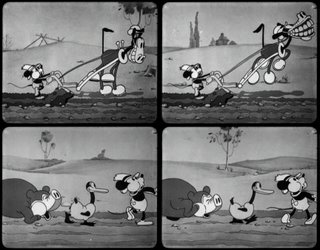
They didn't have color, lines of action, construction, everyone tended to move the same, not much characterization...etc.
This was true for most of the studios in the early 30s, but one studio more than made up for all these early limitations-The Fleischers'.
The cartoons they made from 1929 to 1933 were so creative and so resisitant to formula and rules that they stand to this day as some of the most creative and fun cartoons ever made.
By contrast the Disney cartoons of the same period are extremely generic, bland and boring.
Disney himself was such a conservative guy in his tastes that while he kept advancing technical skill, he resisted imagination and creativity.
I honestly don't know how he survived to the mid 30s with the cartoons he was making in the early 30s.
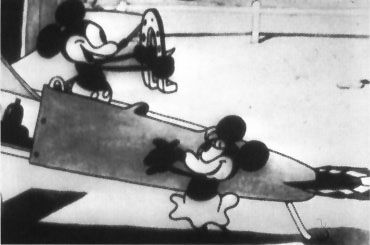
His characters are all pretty much circles and hoses and made up of mathematical proportions.
The Fleischers had a much wider range of character designs and they were hip and they used the biggest jazz stars of the day to do much of their music. Plus they were bawdy and honest. They liked dirty jokes -even rape jokes! They liked funny stuff and surrealism and wanted to please their audience.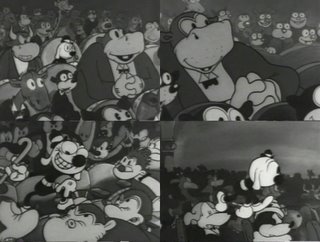
Look. somehow the Fleischers can make circles look funny!

Look. somehow the Fleischers can make circles look funny!
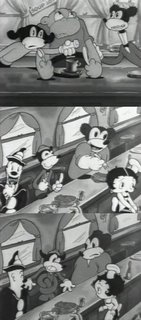
Disney was always a square.
The Fleischers, interestingly were in New York in the early days, along with Van Beuren and Terrytoons. All these studios early on followed their own whims and weren't swept along by the Disney influence that dominated the Hollywood cartoon studios. Not till later and that was their downfall.
To Disney, "more" meant "better". He was going to make his cartoons have more characters, more details in the backgrounds, more colors, more more more.
Anybody have a frame grab of a hugely elaborate scene from an early Disney cartoon I can use as an illustration?
Disney was kind of an average guy except for his ambition. Most regular folk will look at a highly detailed drawing full of cross-hatching or lots of tiny smooth brush strokes and be impressed. "Wow, that painting looks like a photo! Now that's talent!" That's how Disney thought. Disney himself was a cartoonist but not a very good one.
He was also a guy who loved rules and formulas. He wanted everything to be controlled and symmetrical. He needed reasons for everything. Where rules didn't exist, he and his artists invented them. There's a whole book documenting this called "The Illusion Of Life" written by 2 of his animators, Frank Thomas and Ollie Johnston. It actually brags about how the studio took the cartooniness out of cartoons.
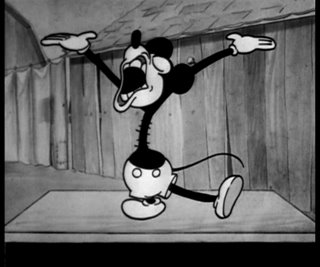
Rare instance of a funny drawing in a Disney Cartoon
Walt must have been on vacation when this scene was animated!
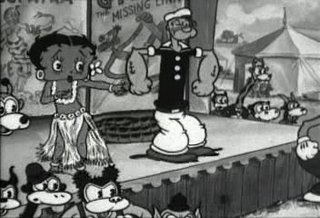
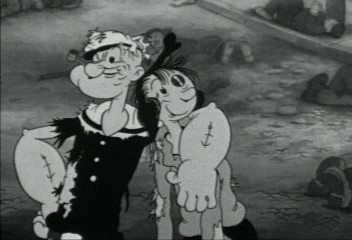
Popeye funny and kinda gross and full of personality
In Hollywood most of the cartoon studios of the early 30s copied Disney's blandness. In fact many of the studios were founded by Disney animators.Ub Iwerks-who was Disney's top animator in the early days started his own studio and managed to make some fun stuff.
Harman and Ising founded Looney Tunes and Merrie Melodies and introduced Bosko and the first talking cartoon. Interestingly, the first few Boskos were very creative, bawdy, funny and had a variety of drawing styles in them, but soon they became standardized and one was drawn about the same as the last.
Disney started the idea that each animator should draw the characters the same way and it became harder to tell one animator from the next. I think this was a huge setback for cartoons, because many animators have strong individual styles and if encouraged to showcase them can add a lot of fun and entertainment to the cartoons. Many later Disney animators were cast according to the way they move things but were still made to keep the characters as "on-model" or generic as they could.
Luckily Tex Avery and Bob Clampett soon took over the creative direction of the Looney Tunes studio. They saved it from being just another bland Disney clone. Most of the other studios tried to become fake Disneys- while dying in the process.
SOME BASIC CARTOON LOGIC OF THE 30S
Whether bland or boring or thrilling and creative all 30s cartoons shared some fundamental good things.Number 1: all the animators timed their work to music. At first they did it very mechanically-right to the beat, but as they got better their timing became more sophisticated and by the 40s, even non-musical cartoons have an invisible meter going all the time and this automatically makes the cartoons feel good.
http://www.animationarchive.org/2006/04/filmography-al-falfas-prize-package.html
The rubber hose style and the moving to the beats was the greatest way for animators to learn. Drawing simple shapes allowed the animators to learn the fundamental principles of movement without being bogged down with all the time it takes to draw useless details. Doing this to music gave them a great sense of timing. Doing it without a lot of control from non-cartoonists allowed the process of inventing animated cartoons to happen naturally through trial and error. It caused the techniques and the art of animation to grow at the fastest rate of any artform in history.
From 1928 to 1940 the medium went from stick figures to the greatest cartoons ever made. Through the 40s the momentum slowed down a bit but continued in a forward direction. The 50s started a decline.
In the 60s cartoons crashed, non-cartoonists stole the medium from us and we have never again been able to get back on a forward moving path for any prolonged period of time.
The advances in technical aspects of animation through the late 30s brought with it an unfortunate by-product. Many of the animators-especially Disney- wanted to leave behind the best attributes of the early cartoons.
There was one cartoon director of the 40s that really preserved the good points of the rubber hose cartoons while taking advantage of all the advances in cartoon techniques. Bob Clampett.
He continued making his cartoons to music and did it better than anyone from the late 30s till today. He kept the silly, surreal impossible cartooniness of the earliest cartoons and added the squash and stretch, line of action and pear shapes that developed at Disney and on top of all that, he added strong and specific personality to the characters.
Warner Bros. pioneered the idea of cartoons having the director's individual personality stamped onto them. Clampett took it a step further by giving each of the characters a living breathing presence. He added the personality and supreme performances.
More on the 40s later.
Thanks to Max and Clarke and especially Marc for helping me out!



